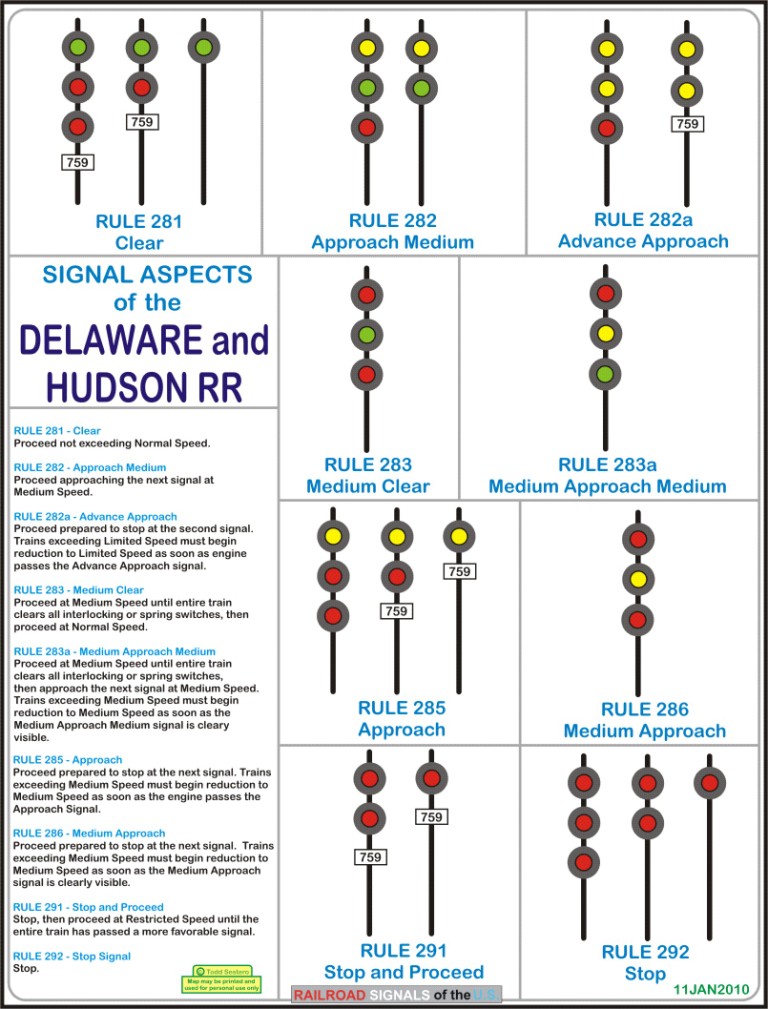Here in the inaugural episode of Better Know a Signaling System I am starting with something small to just sort of see how things go. Actually brevity that is one of the interesting features of the old D&H signal set with only
10 total signal rules in their 1948 rulebook or 9 if you go by this undated chart that appears on
railroadsignals.us
While 9 or 10 signal rules might sound like a lot compared to the 21 or seen in under NORAC or CSX, the D&H finds itself in good company with many other railroads not operating multi track main lines in and around busy urban terminals, especially those making use of route signaling. The D&H is a very conventional speed signaling system designed for single main track operation with passing sidings. If you remember back to my
signaling dialects post you'll see that the D&H uses Y/Y for advance approach, R/Y/G for Medium Approach Medium, R/Y/R for Medium Approach and R/Y or R/R/Y for Restricting. The R/Y/G Medium Approach Medium was made possible because the D&H made a point to use high signals at siding exits and R/Y/R Medium Approach was enabled by using only three headed signals at interlockings. Here is an example of the three head policy that was still in effect up through about 2011 with brand new Unilens tri-heads installed on the former D&H Colonie Branch at CPO-5.
Unfortunately since CP went all Darth Crazy, two head signals are now being allowed to slip through as seen here at CPF-478. Hmmm, looks like they are dumping right handed placement as well.
Contrast with the Boston and Maine's CPF-464 right across the Hudson River which has no problem making use of two headed signals and R/*Y* Medium Approach.
Another interesting practice that comes across on the 1948 signal chart is the use of offset heads for automatic signals. A common practice back in the day, but one that is still followed in Canada to mark automatics instead of number plates. It is not surprising that under CP ownership this practice was not challenged. Although not a new CP install here is the MP 8.2 automatic on the Colonie Branch with the offset heads.
Staying with the 1948 chart we find a few interesting tidbits when it comes to dwarves. Without slow speed indications the D&H could use G/R for clear and Y/R for Approach. R/*Y* was used for Medium Approach to make room for R/Y Restricting. The most interesting dwarf was Y/G for Medium Approach Medium, which I guess came up more than Approach Medium. Single head dwarfs were limited to Y and R/Y Restricting and R Stop. So kudos to the D&H for not installing Slow Speed turnouts I guess.
Aside from its dwarfs the only non-NORACy indication the D&H adopted was the Y/Y Advance Approach. Of course with no slow speed signals it makes perfect sense. There was also a R/Y/Y Medium Advance Approach, which was left off the Railroadsignals.us chart. The thing is that when the Guildford Rail System (ex-B&M) purchased the D&H in the 1980's it did more than re-mile the main line from Binghamton to Maine. In the
2007 CP Northeast US Timetable (towards the end) we can see that the signaling has gotten a lot more...conventional. There is suddenly a R/R/G and dwarf G Slow Clear along with dwarf *Y* Slow App. To compliment those Y/Y is now Approach Slow and *Y* picks up Advance Approach. All the other old dwarfs are just plain gone except for Y/G, which is now Approach Medium.
So that's the story of the D&H signaling system. It started out pretty conventional and then got even more-so after several new owners put their hand in the pie.






I think the searchlight signals are very neat looking
ReplyDeleteI think the searchlight signals are very neat looking
ReplyDelete